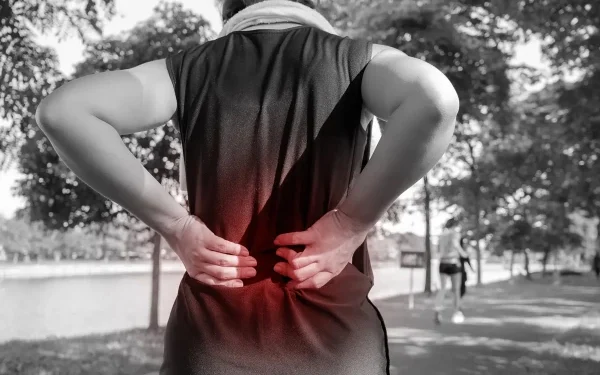Chronic back pain is one of the most common health complaints around the world, impacting hundreds of millions of people and significantly reducing quality of life. While many seek relief through expensive treatments, medications, or invasive therapies, a recent scientific study has revealed a far simpler, low-cost remedy that is accessible to almost everyone: walking.
According to a groundbreaking study published under the JAMA Network Open, walking for approximately 100 minutes a day can reduce the risk of chronic back pain by 23%. This remarkable finding provides hope for those suffering from long-term back issues and reinforces the importance of incorporating physical activity—specifically walking—into daily routines.
What Is Chronic Back Pain?
Chronic back pain refers to discomfort or aching in the back that persists for 12 weeks or longer, even after the initial injury or underlying cause has been treated. Unlike acute back pain, which is temporary and often linked to a specific event or strain, chronic back pain can be persistent, difficult to diagnose, and hard to treat.
It affects people of all ages, but is more common in middle-aged and older adults, often becoming a disabling condition. It can interfere with sleep, mobility, work, and overall well-being.
Alarming Global Statistics: A Growing Health Crisis
According to the World Health Organization (WHO), more than 600 million people globally suffer from chronic back pain, and this number is expected to reach 840 million by 2050 if no effective preventative measures are adopted. It remains one of the top causes of disability, work absences, and decreased productivity.
Back pain also contributes significantly to healthcare costs worldwide, creating economic burdens on individuals and health systems alike. With such widespread prevalence, finding effective, accessible, and affordable ways to prevent or manage chronic back pain is of paramount importance.
The Study: Walking as a Preventative Tool
The recent study was part of the Norwegian Hunt Study, one of the largest health surveys in Norway. Led by Ryan Haddad, a researcher at the Norwegian University of Science and Technology, the study aimed to evaluate the impact of daily physical activity on back health.
Methodology
- Sample Size: Data from 11,000 participants was analyzed.
- Tracking: Participants were asked to wear accelerometers, devices that accurately track physical movement, for a full week.
- Focus: The primary aim was to determine the relationship between walking and the onset or prevention of chronic back pain.
Key Findings
- Individuals who walked for more than 100 minutes daily experienced a 23% reduction in the risk of developing chronic back pain.
- Walking at a moderate or brisk pace provided greater benefits compared to walking slowly.
- The benefits applied even when the total walking time was accumulated in short intervals throughout the day, rather than a continuous 100-minute session.
These findings were further supported by co-researcher Dr. Natasha Pokovy from the University of Sydney, who emphasized that every form of walking helps, whether done in small breaks, throughout daily chores, or in longer dedicated walks.
Why Walking Works
Walking is not just a casual activity—it is a low-impact, weight-bearing exercise that offers multiple health benefits, especially for the musculoskeletal system.
Benefits of Walking for Back Pain Include:
- Improved posture and spinal alignment
- Strengthening of back and abdominal muscles
- Enhanced flexibility and joint mobility
- Better circulation to the spinal discs and muscles
- Reduction in inflammation and stiffness
- Stress relief and mental relaxation, which are often contributing factors to back pain
The Simplicity of Walking: Accessible to All
What makes walking particularly appealing as a treatment for back pain is its simplicity and accessibility. As lead researcher Ryan Haddad noted:
“Walking is a cheap, easy, and accessible form of exercise that almost anyone can do.”
Unlike gym workouts or physiotherapy sessions that require time, money, and planning, walking requires no special equipment, no professional trainer, and no financial investment. It’s an inclusive activity that can be adjusted based on age, fitness level, and time availability.
Tips to Build a Walking Habit
Health experts recommend several strategies to help individuals gradually increase their daily walking time and incorporate it into their regular lifestyle:
- Start small: Begin with 15–20 minutes a day and gradually work your way up to 100 minutes.
- Break it up: Walk for 10–15 minutes several times a day instead of one long session.
- Walk during phone calls: Use long calls as an opportunity to walk around your house or office.
- Choose the stairs: Avoid elevators whenever possible.
- Park farther away: In parking lots, choose spots farthest from the entrance to increase walking time.
- Walk with friends or family: Make it a social activity to stay motivated.
- Use a pedometer or fitness tracker: Apps and devices can track your steps and remind you to move.
Realistic Expectations: It’s Not a Quick Fix
While walking has shown strong preventive potential, it is important to note that it is not a cure-all solution for everyone. Chronic back pain can have multiple underlying causes, including herniated discs, arthritis, spinal stenosis, or trauma. People experiencing severe pain or disability should always consult a healthcare provider.
However, for a large number of individuals, especially those experiencing mild to moderate discomfort, walking can be a first line of defense or part of a broader treatment plan that includes physiotherapy, posture correction, and lifestyle changes.
The Bottom Line: Take the First Step
In a world filled with high-tech solutions and pharmaceutical interventions, this study reinforces a timeless truth—sometimes the simplest actions can have the most profound impact on our health. Walking, a natural movement we often take for granted, holds the power to prevent pain, improve quality of life, and support long-term health in a way that’s affordable, sustainable, and enjoyable.
As chronic back pain continues to rise globally, this research comes as a timely reminder that the solution to many of our modern health problems might just be a few steps away—literally.

























